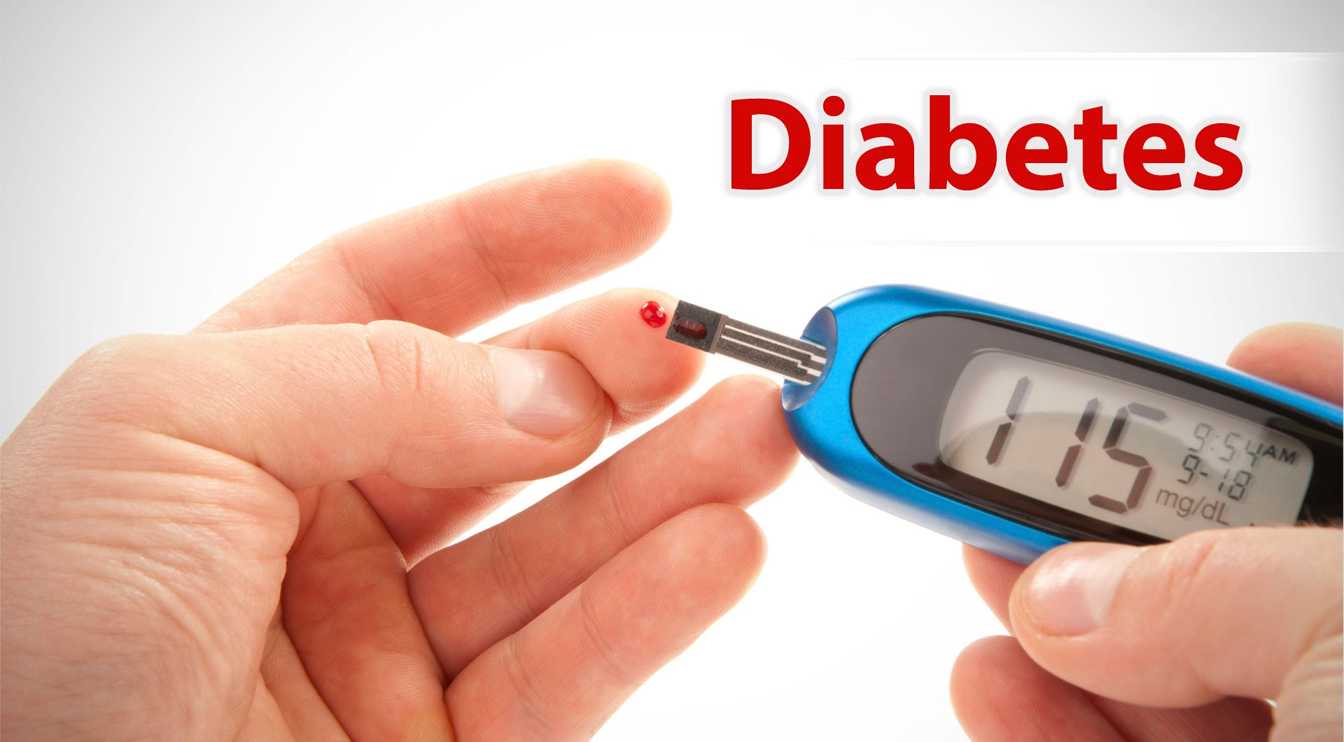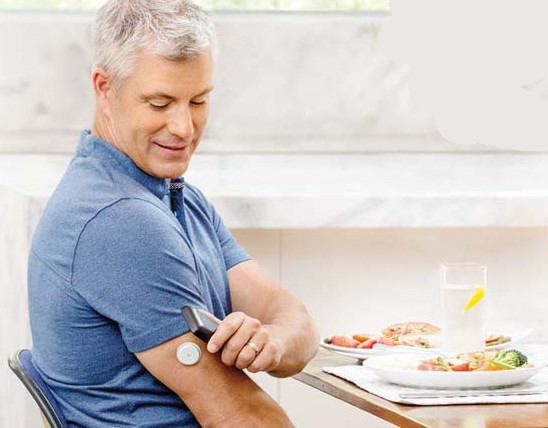By Walter Sorochan Emeritus Professor San Diego State University
Posted February 5, 2019; Updated November 21, 2021. Disclaimer Information presented herein is for informative and educational purposes only and is not intended as curative or prescriptive advice. The staements of this website have not been evaluated by the United States Food and Drug Administration [FDA]. Please consult your medical doctor for help and advice as needed.
 My relative pricked his finger
several times a day for a sample of blood to find out how high his
blood sugar was. This inconvenient finger prick was part of a blood test that is now outdated. High
medical technology has
replaced pricking the finger for blood with using a tiny embedded chip and
cellphone. Instead, blood sugar can now be monitored by a tiny chip
inserted into the body that monitors and sends blood
sugar reading to one's cell phone every five minutes. Not only
monitoring the blood sugar but also sending feedback about the kind of food one eats
that can affect blood sugar.
My relative pricked his finger
several times a day for a sample of blood to find out how high his
blood sugar was. This inconvenient finger prick was part of a blood test that is now outdated. High
medical technology has
replaced pricking the finger for blood with using a tiny embedded chip and
cellphone. Instead, blood sugar can now be monitored by a tiny chip
inserted into the body that monitors and sends blood
sugar reading to one's cell phone every five minutes. Not only
monitoring the blood sugar but also sending feedback about the kind of food one eats
that can affect blood sugar.
My relative is unfortunate as most persons do not have diabetes. As of 2015[update], an estimated 415 million people had diabetes worldwide, with type 2 diabetes mellittus [DM] making up about 90% of the cases. This represents 8.3% of the adult population, with equal rates in both women and men. As of 2014[update], trends suggested the rate would continue to rise. Diabetes at least doubles a person's risk of early death. [12]
But .... we are all better off being informed about preventing diaabetes.
So what is diabetes?
Diabetes mellitus [DM], commonly referred to as diabetes, is a metabolic disorder in which the body does not produce insulin or does not produce enough insulin. This is a medical definition. Another point of view is that it is a symptom that is usually activated by a bad lifestyle. As already pointed out, most persons live with no diabetes, although there appears to be a link between obesity and diabetes in some persons. Diabetes is complex and to understand it, one has to understand the chemistry of diabetes and how it is related to one's lifestyle.
Insulin is a hormone produced by the pancreas and its main function is to move sugar out of the blood into body cells. Most persons with this disorder usually have a genetic link. [1]
There are several types of diabetes, but the most common forms are type 1 [T1D] and type 2 [T2D]. Both T1D and T2D deal with glucose levels.
Perhaps the greatest concern about diabetes is that it is often incubating, over many years, in adolescents and even adults who are obese and overweight; referred to as prediabetics and these persons may not be aware of it. [2] [3] [4]
The good news is that with proper education, diabetes can be treated effectively and even prevented.
Two common types of diabetes:
- Diabetes 1: Only 5 - 10% of people having this type are often referred to as juvenile diabetes. The pancreas produces little or no insulin and the body's immune system destroys the insulin-producing cells in the pancreas. Those diagnosed must inject insulin several times a day and continuously the rest of their life. Symptoms: sudden weight loss, extreme fatigue, hunger, thirst, frequent urination and at times coma. In genetically susceptible people, the onset of diabetes can be triggered by one or more environmental factors, such as a viral infection or diet. [12]
- Diabetes 2: 90 to 95 percent of people have this type. It progresses slowly over 10 to 30 years. There are often no symptoms as the blood sugar is not high enough to cause symptoms. The body continues to produce some insulin but not enough to cause symptoms. Type 2 typically develops after age 40; but has recently begun to appear in children. Symptoms: frequent urination, thirst, hunger and often fatigue. Fatigue related to dehydration and eating problems can also be related to high blood sugars. [5] Type 2 DM is primarily due to lifestyle factors and genetics. A number of lifestyle factors are known to be important to the development of type 2 DM, including obesity (defined by a body mass index of greater than 30), lack of physical activity, poor diet, stress, and urbanization [people moving from country to the city]. [12]
|
Complications linked to badly controlled diabetes [6]
|
In addition to the known ones above, prolonged high blood glucose can cause glucose absorption in the lens of the eye, which leads to changes in its shape, resulting in vision changes.
Diabetes link with colon bacteria: [7]
Research shows that people with type 2 diabetes have different colon bacteria that those without diabetes. Researchers suspect that certain bacteria [staph] can incite an immune response. [7] [8] [9] [10] These large intestine bacteria form toxins that enter the large gut and cause inflammation throughout the body.
Based on this link evidence between bacteria and colon bacteria, medical doctors suggest that diabetics need to eat foods that restore the good colon bacteria.
Prevention:
Diet: Eat plenty of fiber rich fruits and vegetable .... including onions, bananas, avocados, artichokes, garlic, yogurt, sauerckraut, kimichi, pickled vegetables that contain live bacteria that act as probiotics and stimulate healhy bacteria.
Foods to avoid: [1] [11]
Suggestions and tables of complications and foods to eat and avoid are great but often not too practical as these may not be recognized as activating diabetes. For example, eating bad addictive foods that you should avoid can be difficult to recognize in real time. But the human body monitors everything you ingest, reacts and sends messages to your mind-brain. Good foods give you the 'good' feeling. But your body also recognizes bad foods and drinks and sends messages like bloating, feeling bad, discomfort, pain, diarrhea, constipation, headache, vomiting, reflux, itchy nose, and flatulence or stinky gas. The problem for diabetics is that they seldom link bad foods with body signals. But help is on the way!
Dexcom - new continuous hi-tech monitoring system to control diabetes:
 The Dexcom G6 Continuous Glucose Monitoring (CGM) System [13] makes superb diabetes treatment and diabetes management decisions with zero finger-sticks and no calibrations. The Dexcom G6 lets you see your glucose numbers — with just a quick glance at your smart device and receiver. Get alerted when your glucose levels are heading high or low and share your data with up to 5 followers
[including your doctor]. This device can be customized. Dexcom monitors the body
for glucose day and night.The Dexcom G6 is
FDA approved and is covered by most insurance plans.
The Dexcom G6 Continuous Glucose Monitoring (CGM) System [13] makes superb diabetes treatment and diabetes management decisions with zero finger-sticks and no calibrations. The Dexcom G6 lets you see your glucose numbers — with just a quick glance at your smart device and receiver. Get alerted when your glucose levels are heading high or low and share your data with up to 5 followers
[including your doctor]. This device can be customized. Dexcom monitors the body
for glucose day and night.The Dexcom G6 is
FDA approved and is covered by most insurance plans.
There are four aspects to this device: a chip, blood sugar, a smart phone and food; as illustrated on the upper right. There is a small chip that is attached to the upper body that monitors the blood sugar and sends the result every five minutes to a receiver that can be one's iphone [smartphone]. Upon receiving the new results, the chip activates the iphone with a pre-programmed sound alert and displays the new reading.
A most valuable aspect of Dexcom is that by monitoring the highs and lows of glucose, the diabetic can identify within minutes which foods and medications may be causing changes in glucose. This is a sophisticated way to find out not only how fast glucose is high or low but also which foods may be causing the changes. The video below gives more information although Dexcom has a vested interest in selling this product.
Video - Dexcom glucose monitoring system; Length = 7:36 mins.
Source:Dexcom system
Get notified of your lows & highs during the day or while you’re sleeping. See how food, physical activity, and medications affect your glucose levels.
Summary:
Prevention and Treatment involves maintaining a healthy diet, having regular physical exercise, maintaining a normal body weight, and avoiding use of tobacco and drugs. Control of blood pressure and maintaining proper foot care are also important for people with diabetes. Type 1 DM must be managed with insulin injections. Type 2 DM may be treated with medications with or without insulin. Eat foods [fiber-rich fruits, vegetables and fermented foods] that feed good bacteria in the colon and get regular exercise.
Pre-diabetes is reversible: According to national Institutes of Health, pre-diabetes is reversible. [4] Treatment includes making lifestyle changes such as losing weight, exercise and diet.
Finally, diabetics do not need to use outdated finger pricking to monitor their glucose level; instead they can use a continuous monitoring system by Dexcom.
References:
1 Loma Linda University, "Nutrition." Article by 1 Loma Linda University: Nutrition is no longer active.
2 Haemer Mathew A. and others, "Addressing prediabetics in childhood obesity treatment programs: Support from research and current practice," Childhood Obesity, August 2014, Volume 10, Number 4 Haemer: Prediabetics & obesity 2014
3 Jesitus John, "Prediabetes or T2D?" Contemporary Diabetes, April 01, 2015. Jesitus: Prediabetics 2015
4 Mayo Clinic staff, "Tests and diagnosis." Mayo Clinic: testing
5 Haggstrom Mikael, "Symptoms of diabetes." Medical News Today [MNT], January 7, 2017. Article by Haggstrom: symptoms of diabetes 2017 is no longer active.
6 MNT Editorial team, "Diabetes: Symptoms, causes and treatments," Medical News Today, January 5, 2018. MNT team: Diabetes information 2018
7 Piemonti Lorenzo, et la., "Duodenal mucosa of patients with type 1diabetes shows distinctive inflammatory profile and microbiota," Journal of Clinical Endorinilogy and Netabolism, January 2017.
8 Endocrine Society, "Type 1 diabetes linked to gut inflammation, bacteria changes," Science Daily, January 19, 2017. Endocrine Society: 2017
9 Pellegrini Silvia, et la, "Duodenal mucosa of patients with type 1 diabetes shows distinctive inflammatory profile and microbiota," The Journal of Clinical Endocrinology & Metabolism, Volume 102, Issue 5, May 1, 2017, Pages 1468–1477. Pellegrini: Duodenal mucosa & inflammation 2017
10 Norales Sysy, "How the microbe diet can help type 2 diabetes, Diabetes Daily, October 3rd, 2016. [Daily diabetes interview with Ralpael Kellman, MD, author of The Microbe Diet.] Morales: Microbe diet for diabetics
11 eHealthIQ, "5 sure ways to control type 2 diabetes through diet," eHealthIQ, March 03, 2016. eHealthIQ: 5 ways to control diabetes 2016
12 Wikipedia, "Diabetes mellitus." Wiki: Diabetes
13 Dexcom, "The New dexcom." Dexcom: New blood sugar monitoring